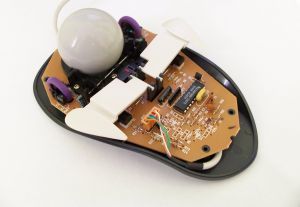Trackballs
Society has spawned many different computers over the years that do many different things. Likewise, there have been many different devices invented to collect input from the user in order to control those computers. One of these input devices is the trackball. Trackballs have been widely used in many different fields over the years for a variety of applications. While mice and touchpads have almost completely replaced the trackball in home computer use, trackballs still play a crucial role in several different industries. This article will explore what trackballs are, how they work, and how they compare against computer mice.
What are Trackballs
Trackballs are basically upside-down computer mice. Trackballs were much more popular before the invention and mass production of the touchpad, which is now included in every laptop computer. Trackballs may be a little more uncomfortable to use for some users but they are great for work areas that have little to no space for extra appliances. Trackballs are often found in CAD work stations, game console controllers, and navigational equipment.
How Do Trackballs Work
As was mentioned earlier, trackballs are essentially upside-down mice. Whereas a mouse consists of a casing with a ball or sensor at the bottom, trackballs consist of a casing with the ball at the top. Mice require that the user move the entire casing in order to move the cursor while trackballs have a casing that sits still on a desk and require that the user move the ball itself with a thumb or finger in order to move the cursor. Sensors beneath the ball measure movement and send an electrical signal to the CPU in the computer to tell the cursor to move in the desired direction.
Trackballs Vs. Mice
Trackballs and mice used to go head-to-head in mainstream computer forums but now the debate about which one is better is rather limited. Trackballs certainly provide more flexibility and better precision in specific applications while mice allow the user to comfortable control the cursor with a flick of their wrist. The following is some more in-depth pros and cons of trackballs when compared to mice.
Pros
Precision
Trackballs are significantly more precise than computer mice because there is nothing in between the user’s finger movement and the ball. In mice, the ball is pressed against a desk or mousepad and only senses the user’s hand movement due to the amount of pressure that the user is applying to the mouse. Trackballs do not have this setback which is why they are used in applications such as design, gaming, and navigational control.
Accessibility
Since trackballs respond directly to the user’s touch, they do not need to be rested on a flat surface. This means that users can put the trackball on their lap, a small table, or anywhere else that a mouse would not be suitable for. Likewise, trackballs are more accessible because they do not require extra room for the user’s arm motion. The only amount of space that a trackball needs is the size of the device itself.
Cleanliness
Trackballs are generally cleaner than computer mice because users’ hands are usually cleaner than a desk or other computer-based surface. Mice collect dirt, dust, and other debris that is scattered on a user’s desk. This debris can get caught in the ball or interior wheels and interfere with cursor movement. Trackballs do not have this problem simply because the ball is on top of the case rather than beneath it.
Cons
Difficult To Learn
Trackballs can be difficult to learn, especially for users who are accustomed to using a computer mouse. Whereas a mouse only requires that the user move his/her arm and wrist in order to move the cursor, trackballs require that the user move his/her fingertips in a coordinated path for each cursor movement. This can be awkward and can even lead to pain in the user’s fingers due to RSI (Repetitive Strain Injury).
Bulkiness
Trackballs are generally larger than computer mice and can be awkward for the user to rest his/her hand on. While trackballs can be moved easier than computer mice and do not require additional room for the user’s arm, the initial size of the device takes up more room than a computer mouse.
Expensive
Despite the fact that computer mice have dominated home computer use, trackballs are still more expensive than computer mice. Whereas a user might find a decent, new computer mouse for $20, a new trackball may cost around $100.


Comments - No Responses to “Trackballs”
Sorry but comments are closed at this time.